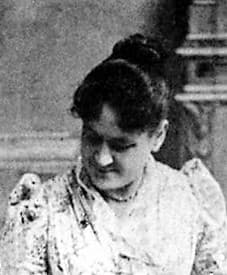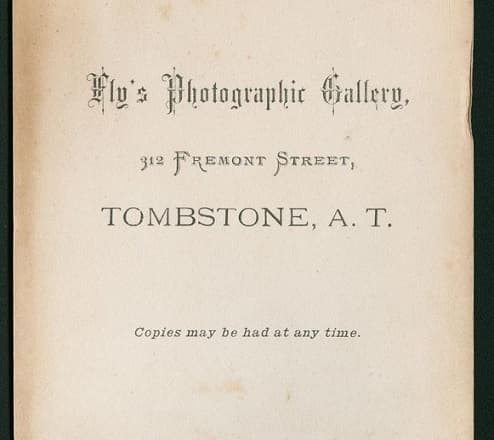Camillus Fly was possibly the most important person in showing us the visual history of the Wild West! He photographed many scenes of Old West events and life in the 1800s. With photography in its infancy, and the circumstances he encountered in his field work – that took a great deal of effort.
He moved into Tombstone, Arizona in 1879. Many refer to him as C.S. Fly. Let’s see what he did here in Tombstone, and in Arizona.
Today – Tour a Remake of Fly’s Photography Gallery
Camillus Sydney “Buck” Fly
Camillus S. Fly started life in California. He was born on May 2, 1849 in Missouri. But soon thereafter his parents migrated West. He grew up in Napa County. His friends and family called him “Buck.”
As he reached adulthood, he did some farming. But then he took up photography. He found his calling!
He met Mary Goodrich and they fell in love. Her maiden name was McKee. Her friends called her Mollie. She had divorced her first husband. That was a rare act for an Irish woman in those times. She had also taken up photography. Likely a common interest that got them talking!
Marriage & a Move

On September 29, 1879 Mollie and Buck were in San Francisco. Why? In town to get married. They had further plans. They decided to make a new life together in the Arizona Territory. They moved to Tombstone in December of 1879.
They also had a child named Kitty. It’s not known if she was from Mollie’s prior marriage, or if they took her in as an adoptee.
Tombstone had started to boom with activity. They set up a photography studio in town. Like most new-comers, they put their business in a tent! Soon they began construction on a more stable business environment. They began fabrication of a wooden building.
Their structure went up at 312 Fremont Street. It contained their studio. That’s where they shot formal portraits. They advertised for them, and received quite a few local takers. Fly often used a method called the Cabinet Card.
[See Information Here On Cabinet Cards1>]

Typically Camillus or Mollie would take a portrait in their studio. They developed it onto thin photography paper. The cabinet card, thicker 4-1⁄4 x 6-1⁄2 inch card-stock was adhered to the back of the photo. It served two purposes:
- more stability and durability for the photograph
- business advertisement + ad for additional copies of that photo
Cabinet card photography was quite popular during the late 1800s. The style began to die out when the new, affordable invention of the Brownie Camera was available.
Their business also provided rental rooms for additional income as a boarding house. Doc Holliday even roomed there. That was his residence at the time of the Infamous Gunfight.
Native American Photography
C.S. Fly was well-known for getting wonderful, exclusive photographs of Native peoples. His subjects were often posed by Camillus Fly. But sometimes he was able to get candid shots of them going about their daily lives.
An example of a posed photograph is below, of Apache warriors, taken in 1880. From Left to Right are:
- Massai
- Apache Kid (Haskay-bay-nay-ntayl) – taken when he was a Sergeant for the U.S. Army
- “Rowdy”

On a trip to Tombstone Arizona – be sure to stop in to the O.K. Corral. You’ll see the actual gunfight site area, and learn the details of what happened that day. At the O.K. Corral Gunfight.
The re-creation of C.S. Fly’s Photography Gallery is also on the same property. Why is there a Re-Creation? A sudden event occurred later on, that made that a necessity. We’ll tell you – don’t worry! Can’t wait? Read it Now>
Camillus Fly & Geronimo
C.S. Fly had a vision for his photos. He traveled to events and places to capture unique moments. Mollie took care of the home-front business interests. She managed the Fremont Street studio and the lodgings.
In March 1886, Camillus Fly heard of Geronimo’s intent to meet with General Crook.

Camillus Fly gathered his photography equipment and headed to Cañon de los Embudos with the military. He didn’t hesitate to ask Geronimo and his warriors to stand a certain way, or pose their head in a specific position. They complied politely.
That particular photo is below. Apache leader Geronimo is on the right. His warriors from left to right are: Yanozha (Geronimo’s brother-in-law), Chappo (Geronimo´s son by his 2nd wife) and Fun (Yanozha´s half brother).

Gunfight at the O.K Corral
It was October 26, 1881. Camillus Fly was inside the Photography Gallery. Just outside his studio, in a vacant lot West of his building a ruckus began. He heard gunfire!
After it died down, he ran outside into the lot. A rifle was in his hands. He saw Billy Clanton on the ground weakly reaching for his gun. He ran over and disarmed Billy. Soon thereafter, Billy died. That was his initially memorable part in this OK Corral Shootout>.
He didn’t take any photos of the gunfight aftermath. But he did take the most famous photo of the victims in their coffin. C.S. Fly took the photo below of (left to right) Tom McLaury, Frank McLaury and Billy Clanton. This is the only known photo of Billy Clanton that was ever taken.

Photo OF C.S. Fly
With all the many, many photographs that Camillus Fly had taken over his years, especially while living in Tombstone Arizona – did he ever bother to get one of himself? It seems he may not have. Or if he did, it may have been destroyed (more on that below).
There is one rendering of C.S. Fly that’s posted on a genealogy website. Someone uploaded it there. But there is no documentation along with it, validating this view. Thus we feel it’s a mystery, at the moment. But will continue with further research on this subject, and update if we find more on it!
Some Fly Troubles!
Mollie became disillusioned when her loving partner, Buck, began drinking too much. She left him for a time and moved with Kitty to Florence AZ in 1887.
Camillus was often on the road and occupied elsewhere. He tried a little mining. C.S. Fly’s mining interests apparently didn’t have great returns. He also had a ranch called Fly’s Park, located in the Chiricahua Mountains.

While involved in these other diversions, he still found the time and place to capture the old West in his photographs. It seemed he always had his photography equipment with him – probably at the ready, as near as possible.
An example is the photo here by Camillus Fly. It was captioned: “Discoverer of the Copper Queen Mine” – pictured is George Warren. It first appeared in a Souvenir of Bisbee published in 1900.

Since Camillus Fly was out and about so much of the time, Mollie came back to Tombstone to run the business there. She was really needed at the Gallery to maintain the center of their business.
Mollie and Buck really were, what people refer to as “soul-mates.” Yes, it appeared that they couldn’t live with each other – yet they couldn’t stay apart. Southern Arizona newspapers followed their comings and goings pretty regularly. By reading the locally chronicled reports of that time, you really can see their separations and re-connections.
C.S. Fly’s Life’s Conclusion
C.S. Fly’s photos were published in well-known periodicals. He was creative and a hard drinker. He was a busy man, well-known, and always involved in something. He served as an electoral delegate and on the local Grand Jury. He was popular enough to be elected Sheriff of Cochise County for one term in 1894.
Then in the late 1890s, his lawman term was complete. Tombstone’s economy was suffering. The Flys looked for better opportunity. They got a place in Bisbee, which had a better outlook. Mollie still continued running the Tombstone studio.

By the turn of the century Camillus Fly’s health was really deteriorating. He had a bacterial skin infection which brought complications leading to his death. Mollie was at his side when he succumbed in Bisbee on October 12, 1901. He was only 51 years old.
He is buried in the older section of the Tombstone City Cemetery. Mollie continued working the Gallery in Tombstone until fire destroyed the building in 1912. All of the Camillus Fly work that Mollie managed to salvage, she graciously donated to the Smithsonian. If you desire to research some of them, Archives Are Available from the Arizona Historical Society.

Tombstone Fire – Photo Gallery Burns

Even though many of his photos were lost – many remain. Because of Camillus S. Fly, we get a great look of the history. That’s a visual look which can’t be beat!
References
Vaughan, T. (1989). C. S. FLY: Pioneer Photojournalist. The Journal of Arizona History, 30(3), 303-318. Retrieved from http://www.jstor.org/stable/4169576
1 Knoblock, S. (1995-2005). Cabinet card. Retrieved from city-gallery.com/learning/types/cabinet_card/index.php

